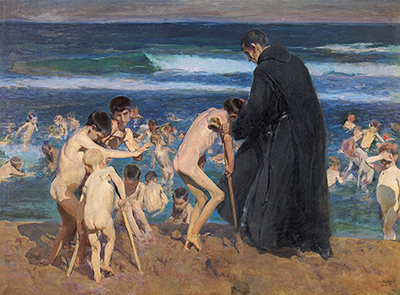Sad Inheritance is a Joaquin Sorolla composition created in 1899. For many years, the painting was owned by the New York Episcopal Church of the Ascension. However, in 1981, the painting was sold to the Savings Bank of Valencia.
The Sad Inheritance is quite a large oil on canvas painting whose dimensions are 284 cm (width) and 208 cm (height). It is perhaps one of the factors that led to the success of Sorolla’s career in the United States and Spain. The theme of the painting is social realism. At the time when this composition was created, Sorolla had worked on quite a few paintings of the same theme. So much that he was termed a social realist artist. The reason for this title was that he tried to illustrate different people and their lives in the most realistic way possible. For this particular painting, Joaquin Sorolla displayed a sad image of disabled kids on the beach. The scene in this painting is the beach in Valencia, where Sorolla owned a beach house. This is one of many pieces with the same location by Joaquin Sorolla.
The subject matter of the Sad Inheritance is a group of disabled children who are bathing at sea. To showcase the fact that the kids were crippled, Sorolla went as far as to show some of them using crutches and some being helped up. The kids in the painting are all naked and bathing in the seawater. With the kids is a monk dressed in a black robe. The monk appears to be helping one of the kids with the crutches to move. The rest of the kids are playfully enjoying the active waters in the sea. It is hard to tell if the other kids in the water are also crippled or not. In the background is the sea, which is masterfully painted in a manner only Sorolla can achieve.
In the late nineteenth century, Valencia and its environs were struck by the polio epidemic. As a result, several kids were disabled. This painting is a display of the impact of the polio epidemic. The monk on the image depicts a member of the asylum hospital of San Juan de Dios, who handled most of the polio cases. The kids being at sea depicts the use of water as a therapeutic measure for the condition. The painting is an exact image that Joaquin Sorolla once came across from his beach. In an interview, he recalled witnessing the scene one morning from a distance while he was sketching Valencian fishermen. Before embarking on the creation of the Sad Inheritance, Sorolla had to obtain permission from the director of the hospital where the kids and the monk were from. With their authorization, he went on to recreate the exact scene with oil on canvas.
In 1900, Sorolla exhibited this painting at the Universal Exhibition in Paris. This led to him receiving the Grand Prix and the Medal of Honor. A year later, he received another medal of honour at the national exhibition in Madrid for the same composition. He went on to receive several other awards, and his career was never the same after that. Joaquin Sorolla attempted to sell the Sad Inheritance to the Spanish Government. However, conservative politicians in the state hindered the acquisition. He ended up selling it to Jesus Vidal, a dealer in New York. The dealer sold it to John E Berwind, who gave it to the Episcopal Church of the Ascension in New York. The painting is, therefore, not part of the Museo Sorolla in Madrid.




